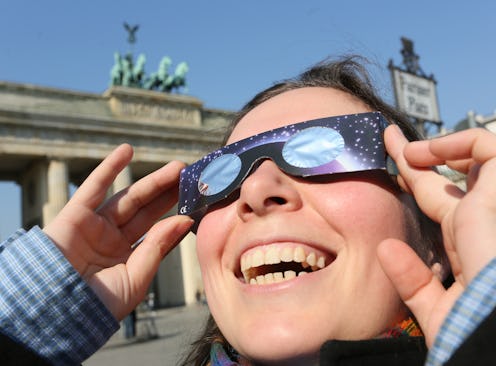
With all the news flying around about counterfeit solar eclipse glasses, and the risk of permanent eye damage, it might be hard to feel confident in your solar eclipse specs. Here's one other thing you may not have thought of: How long is it safe to wear your solar eclipse glasses? Once you've determined that your solar eclipse glasses are the real deal, make sure to read the fine print. For example, mine warn that they should only be worn for three minutes of continuous use intermittently for several hours, however, if your glasses are ISO approved, and made after 2015, you can stop reading this right now because you're all set.
"According to the AAS, you don't need to worry about limiting your time in the specs; some glasses will warn against more than three minutes of use, but ISO-certified glasses made after 2015 can be used indefinitely," Rachel Feltman reported for Popular Science.
So, just when is it safe to remove your solar eclipse glasses? If you're in the path of totality you can remove your glasses when the shadow of the moon is completely blocking the sun, according to Travel + Leisure. But, if you're one of millions viewing the partial solar eclipse, you'll need to keep your glasses on the entire time.
If you have the glasses that advise only for using for three minutes at a time, and you're not sure if they were made after 2015, this doesn't mean you should take them off after three minutes. Instead, just look away from the eclipse for a minute to give the glasses a break. If you're not sure if this applies to your glasses, read the fine print on the inside of the arm of your solar specs.
However, if your glasses are phony, you shouldn't wear them at all. Since counterfeiters are using the names of real companies to market bogus specs, it's hard to tell the real deals from the fakes. Here's one way to be sure.
"You shouldn't be able to see anything through a safe solar filter except the sun itself or something comparably bright, such as the sun reflected in a mirror, a sun glint off shiny metal, the hot filament of an unfrosted incandescent light bulb, a bright halogen light bulb, a bright-white LED bulb (including the flashlight on your smartphone), a bare compact fluorescent (CFL) bulb, or an arc-welding torch," the American Astronomical Society explained.
If you can see through your glasses they're likely knock offs. But, all is not lost. You can still view the eclipse in selfie mode on your smartphone, or by using a pinhole projection, which you can easily make with your fingers.
"Just cross the outstretched, slightly open fingers of one hand over the outstretched, slightly open fingers of the other," the American Astronomical Society explained. "Then, with your back to the sun, look at your hands’ shadow on the ground. The little spaces between your fingers will project a grid of small images on the ground. During the partial phases of the solar eclipse, these images will reveal the sun's crescent shape."